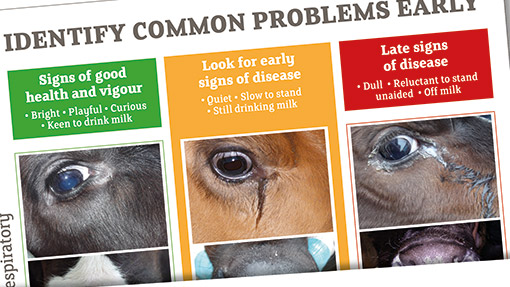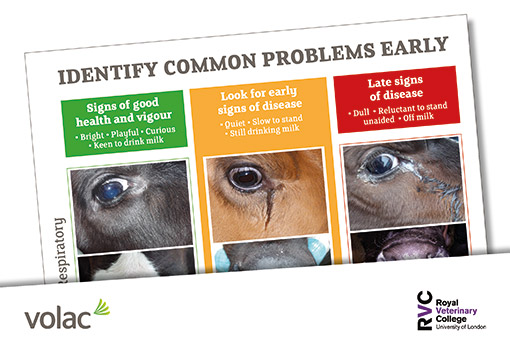Livestock event 2014: Traffic light system to keep calves healthy

A new traffic light poster launched at the Livestock Event will help farmers identify the early signs of scours and respiratory disease and ultimately reduce their heifer mortality.
Mortality is currently running at about 14% prior to first calving and in a study carried out by the RVC looking at 500 calves across 12 farms, half have had scours and 45% pneumonia.
These rates are quite high compared with other countries and reflects the challenging climate in the UK for rearing calves, said vet and researcher at the Royal Vet College Kate Johnson.
The Healthy Calf traffic lights
- Green: Look for signs of good health and vigour in calves. Calves in good health should be bright, playful, curious and lively with clear eyes and nose, clean hindquarters and be keen to drink milk.
- Amber: Act at early warning signs of problems – remember going off milk is a late sign of sickness. Contact your vet or implement a treatment plan.
- Red: Late signs of disease – these are calves at risk of death.
“Farmers have become so used to seeing these symptoms that they sometimes see it as the norm,” she told a briefing at the Livestock Event 2014.
See also: Free online learning in our Calf Scours Academy
But both scours and respiratory disease impact not only on husbandry demands and vet costs, but for those animals which survive, it also influences their subsequent performance, said Volac’s youngstock specialist, Jessica Cooke.
“Even a relatively mild case of respiratory disease takes energy away from growth, with up to 1kg lost per week.”
Called The Healthy Calf, the poster by the Royal Veterinary College and Volac is designed to be pinned up in the calf shed and uses a traffic light system for the symptoms (see box), red for severe cases to green for healthy calves.

“Identifying mild cases of disease among calves, particularly group housed, can be so easy to miss compared with spotting and subsequently treating the really sick calves,” said Dr Cooke.
“Milk rejection, for example, is often used as a sign of disease, however it is far from accurate. If calves are fed less than eight litres of milk per day, it will only be at the final stages of disease that a calf will stop drinking.”
At this point, the calf may be so sick that the damage caused will be irreversible, therefore, the poster is designed to help all farmers and those responsible for calf rearing to identify the early signs of scours and respiratory disease.
“Early ones [in amber] can still be fixed,” says Ms Johnson.
“Farmers have treatment protocols, but many are unsure when to start using them and when to get the vet involved,” adds Ms Johnson.
Copies of the poster are available from Volac, call Freephone 0800 919808
